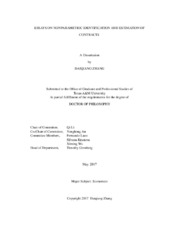| dc.description.abstract | Due to the fundamental role of asymmetric information in economic relations, during the past decades contracts have flourished and dedicated to how the information asymmetry and incentives induce strategic behavior among economic agents in a number of directions. One branch of contracts focuses on bilateral contract between one principal and one agent, in which the agent’s hidden information and hidden action lead to the adverse selection and moral hazard problems, respectively. There is a simple and widely used menu of contracts, which consists of two types of contracts: the fixed-price contract in which the payment is fixed regardless of the realized cost, and the cost-reimbursement contract in which the payment equals the realized cost.
By allowing for a more reasonable property that the optimal effort is monotone in the agent’s type, we show that the performance of the optimal FPCR contract relies crucially on the cost function: when the marginal is relatively large, the gain of the optimal FPCR menu is very close to the fully optimal contract. Otherwise the optimal FPCR menu behaves arbitrarily close to a cost-reimbursement contract.
To quantify the renegotiation cost without commitment in a two-period setting, we nonparametrically identify and estimate the model primitives, including the agent’s cost function and disutility function of effort, the distribution of innate, agents’ bargaining power and the intertemporal preference. The empirical evidence shows that the nonlinearity of agents’ cost function implies different empirical results about the distribution of welfare gains between firms and taxpayers.
The second branch of bilateral contracts between one principal and multiple agents emphasizes the externalities generated by the dependence of one agent’s payoff on other agents’ contracts, while the first branch of contracts involves no externalities due to the setting of one principal and one agent. To quantify the payment effect of bargaining power, I nonparametrically identify and estimate the model primitives, including the manufacturer’s cost function, the hospitals’ payoff function, the joint distribution of hospitals’ payoff-shocks, and hospitals’ bargaining power. And, we conduct counterfactual analysis of the effect of the bargaining power on the price. | en |


